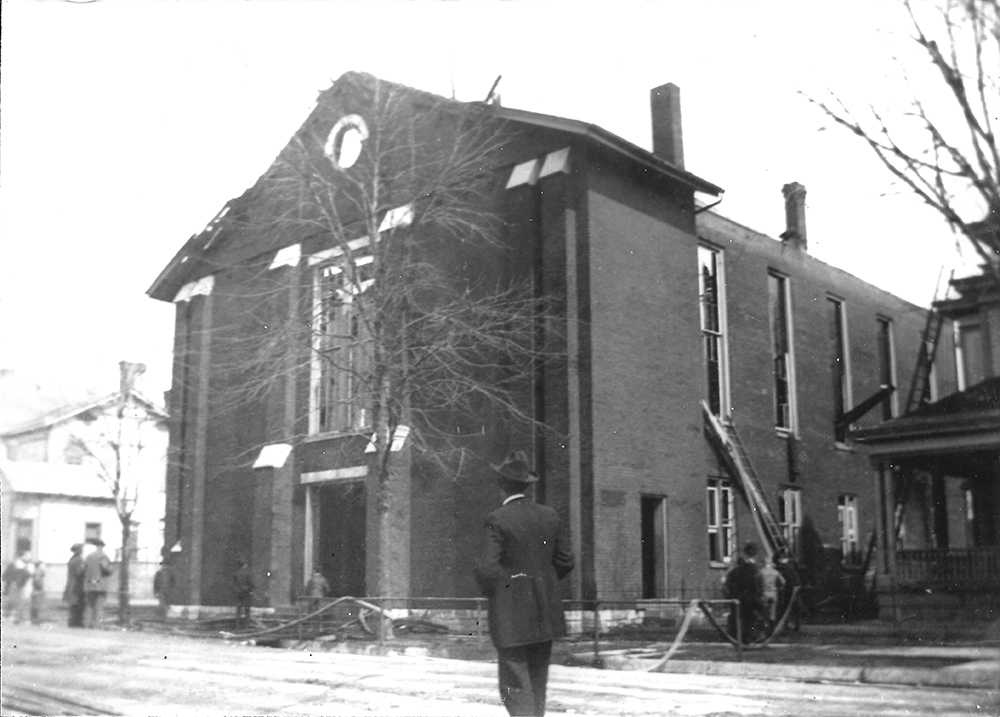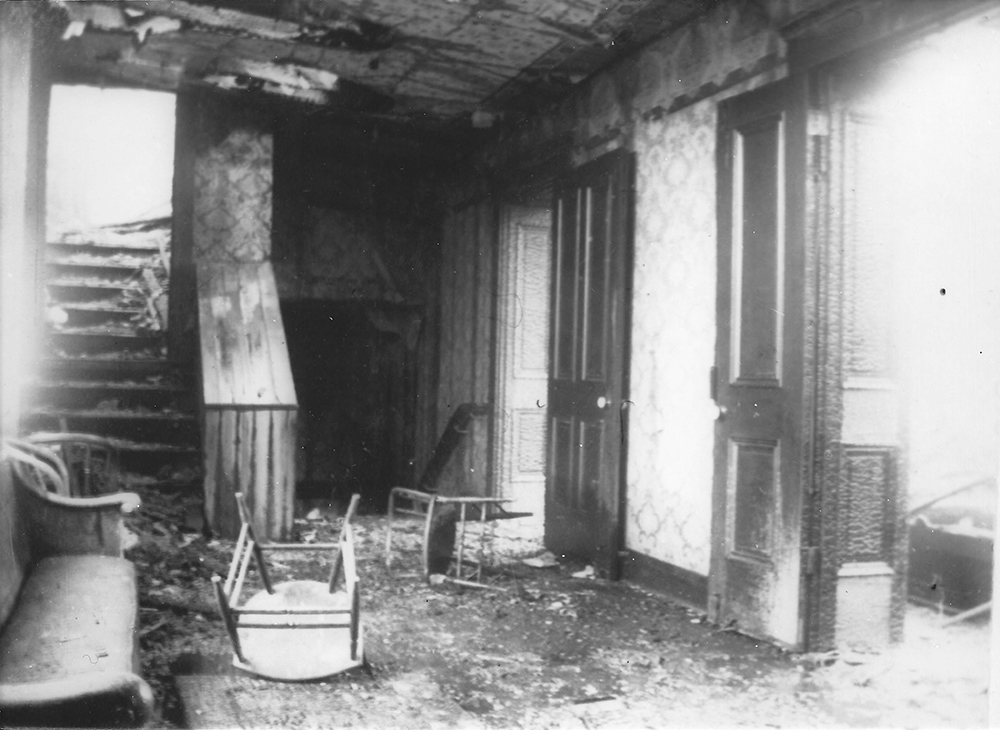Historical photographs of Troy show a variety of events that have taken place in local churches down through the years: congregations listening to long ago pastors, choirs singing hymns, children in holiday pageants and images of buildings as they looked in years past. One series of photographs shows a terrible event that occurred on an Easter morning over a century ago.
 These photographs show a fire that destroyed the Troy Methodist Church on April 2, 1899—an Easter Sunday morning. Back then, the church was known as the Methodist Episcopal Church and it was located on South Mulberry Street. (Today, the Church is known as the First United Methodist Church of Troy and it is at the corner of West Franklin and Cherry Streets.)
These photographs show a fire that destroyed the Troy Methodist Church on April 2, 1899—an Easter Sunday morning. Back then, the church was known as the Methodist Episcopal Church and it was located on South Mulberry Street. (Today, the Church is known as the First United Methodist Church of Troy and it is at the corner of West Franklin and Cherry Streets.)
The Methodist denomination started in Troy about 1810. The first Methodist services were held in a carpenter shop at the intersection of Clay and Water Streets. In 1812, the congregation constructed a log building at Clay and East Main Streets for their worship services. The land for the church was given by early resident William Gahagan, who is believed to have owned 87 land lots in Troy. They built their first church on South Mulberry Street in 1825. It has been reported that the congregation paid $25.00 for the lot on which the church was built. A second church was built on the Mulberry Street lot in 1839 and the first church (built in 1825) became the church parsonage. The 1839 church was renovated and expanded between 1863 and 1865. It was this last church that was destroyed by the Easter Sunday fire.
Ironically, the congregation had been considering building a new church at the time of the fire. Months earlier in February 1898, a committee had appointed to study the possibility of constructing a new building.
The fire was discovered around 10:30 a.m.—just after the end of Sunday School and before the worship service began. The book History of the First United Methodist Church of Troy, Ohio 1811-1876 by Judy Tanis Parr says, “The fire, first discovered burning through the roof near the steeple, soon spread, the flues of the furnace allowing easy access for the fire to all parts of the building.” Historical records do not tell who discovered the blaze, but they do say that Troy Superintendent of Schools Charles Van Cleve calmly announced that the church was on fire and told people to leave the church building. How the fire started is not known. It is thought, however, that it started in the furnace flues or in an old chimney.
The Troy Fire Department quickly arrived at the church, but water pressure was low and the interior of the church was soon engulfed in flames.
 The church history book by Judy Tanis Parr also tells a story about Rev. Stanley A. Royal, a pastor at the church. In her book, Ms. Tanis Parr wrote, “Miss Ruth Hartley recalls Rev. Royal’s pacing up and down Mulberry Street while the fire was blazing away, ‘I didn’t pray for the church to burn’ he said, wringing his hands, ‘but I just wanted a new church.’”
The church history book by Judy Tanis Parr also tells a story about Rev. Stanley A. Royal, a pastor at the church. In her book, Ms. Tanis Parr wrote, “Miss Ruth Hartley recalls Rev. Royal’s pacing up and down Mulberry Street while the fire was blazing away, ‘I didn’t pray for the church to burn’ he said, wringing his hands, ‘but I just wanted a new church.’”
Worshippers going to and from other Troy church services stopped by to look at the fire. Services in churches around Troy were delayed about 30 minutes because of the fire. Thomas Bemis Wheeler said in his book Troy the Nineteenth Century: “As services in other churches were over, men and women in their Easter Sunday best came to watch the fire. Soon people from all over town flocked to Mulberry Street.”
One of the most dramatic moments during the fire had to do with the falling of the church steeple. For years, the steeple had been a Troy landmark that was visible from miles away. A gathered crowd watched in shock as the church steeple swayed back and forth. The Buckeye newspaper of April 6, 1899 reported:
For five minutes the crowd stood in suspense, waiting for the steeple to fall, wondering if it would fall into the street, thereby endangering the lives of the firemen, or fall to the south and bring rain upon the Methodist parsonage, or lean to the north and set fire to Dr. Means’ property. The steeple began to sway and the crowd pushed backward. It leaned heavily towards the south and parsonage seemed doomed, when, with a crash, it tumbled upon the blazing roof of the church, crushing it in. A vast column of smoke poured out of the building, and sparks were carried for squares while angry flames burst from all the windows.
Most of the church was destroyed. Luckily, no one was injured. A few pieces of church furniture, a recently-purchased piano and some books survived the fire. The church bell, which fell with the steeple, also came through the fire. It was later donated to a Methodist Episcopal Church in De Funiak, Florida.
Church minister, Rev. Royal, is thought to have been a well-organized man. While the fire was still burning the church, he posted a notice that church services would be held that evening in the Grange Hall at the Miami County Courthouse.
The Buckeye newspaper article also says that even while the ruined church was still smoldering, the Baptist, Christian Lutheran and Presbyterian churches in Troy sent messages of sympathy to the Methodist Church and offered the use of their buildings as long as they needed a building.
Two months after the fire in June 1899, ground was broken for a new church at the corner of West Franklin and Cherry Streets. In November that year a cornerstone was laid. A new church was dedicated on May 12, 1901. That church is still in use today.
For further information about this story, contact the Troy Historical Society at (937) 339-5900 or by email at This email address is being protected from spambots. You need JavaScript enabled to view it.. Historical records about the fire are available for research at the Troy-Miami Public Library Local History Library, 100 W. Main St. in Troy.

